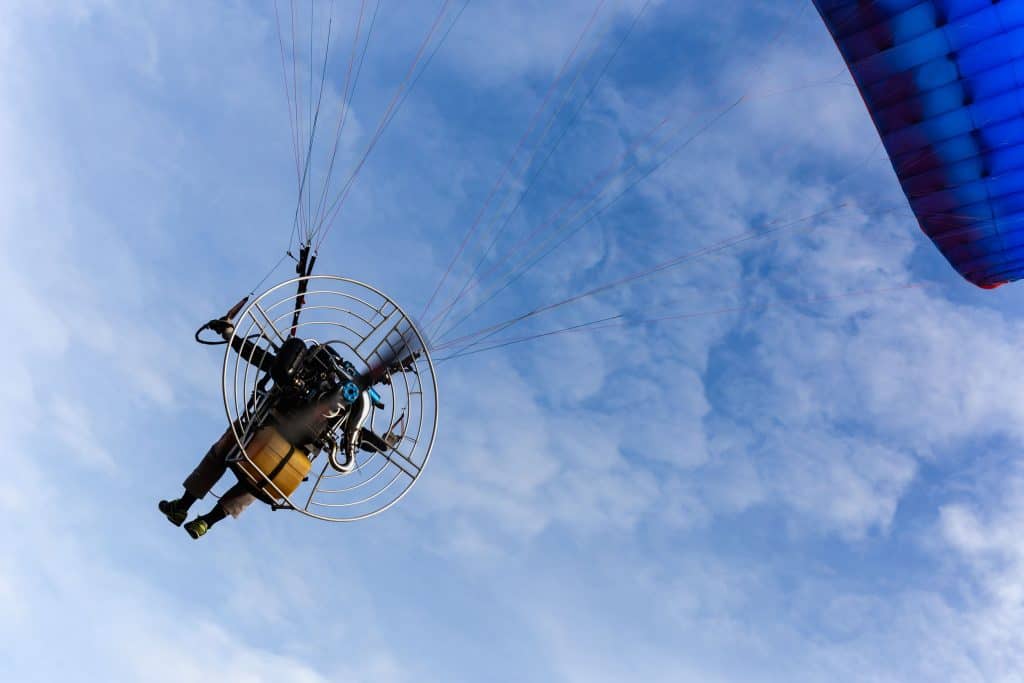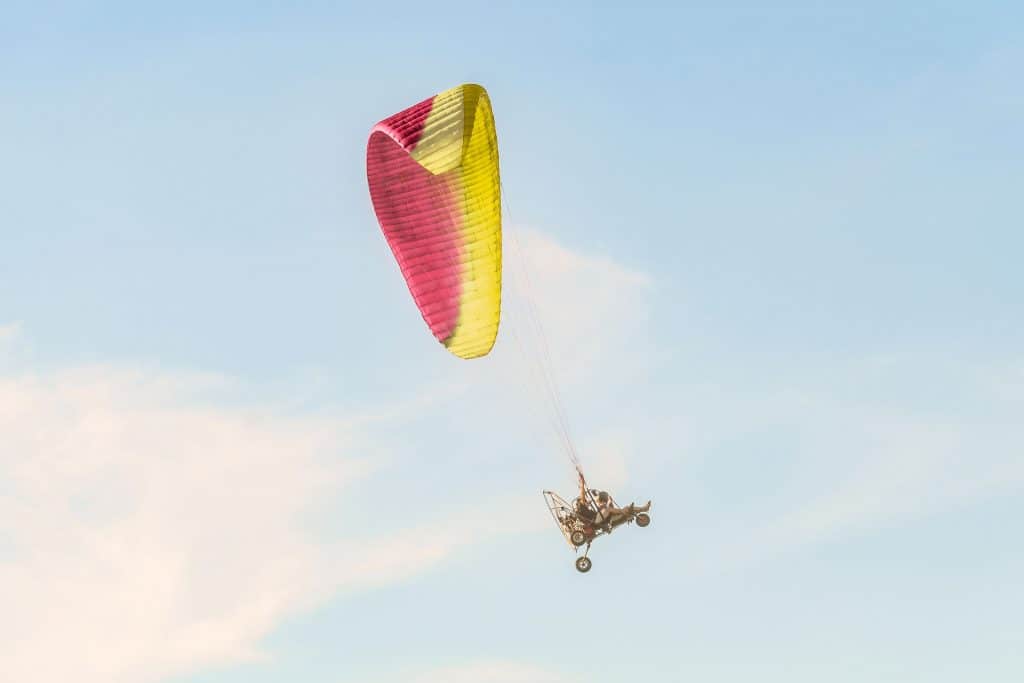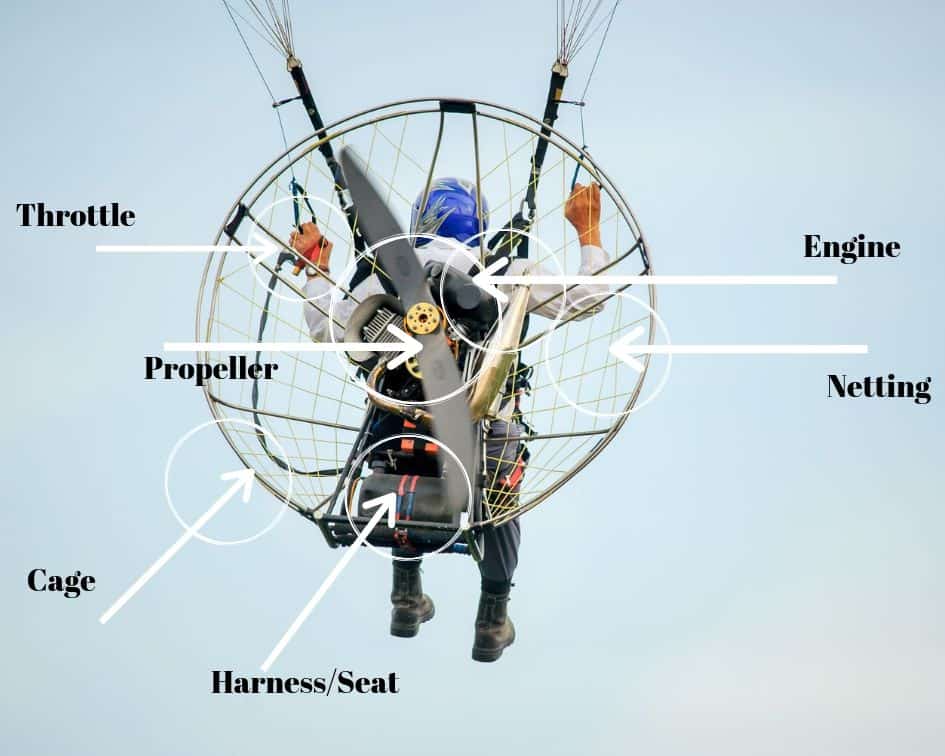
You’re never too young or too old to learn something new! Paramotoring is as easy as driving a car, but do you have to be 16 years old to fly paramotors just like with a car?
In the United States and the United Kingdom, there are no age requirements for a paramotor pilot. The average pilot age is 37, but there are paramotor pilots as young as 9 years old and as old as 80. In countries such as Canada, a pilot has to be at least 16 years old to hold a permit and fly.
Paramotoring is a “young” (doesn’t have a long history) sport and not well explored as yet. You don’t even need a license to fly a paramotor in the U.S. and there are no laws specifically catered to paramotoring.
How Old is Too Old? How Young is Too Young?
You’re only as young or old as you feel…you ever heard that before? Well, in the paramotoring world, it doesn’t matter how young or old you feel, it only matters that you have a desire to fly a paramotor.
Thank goodness there’s no age requirement or limit to paramotoring! It may just be my opinion, but it’s nice to see a sport that is still in the youth stages of regulation. We’ll probably see more regulation coming up in the near future, but for now, we’re content with what we’ve got.
It’s all fine and good to say that there is no age requirement for flying a paramotor, but seeing them in action is another story. There are tons of videos on YouTube with not just paramotors, but also with paragliding.
Do you want to see some pilots in action? I do! These videos are a great example of just a few of the great things human beings are capable of. I enjoyed both of them.
Kids are smart, they’re capable of more than you might think. My siblings and I took my mom’s Bosch (a.k.a. electric mixer) upstairs in the middle of the night and perfectly followed a cookie recipe and then ate all the cookie dough. I’m pretty sure we were all under the age of 14. There were five of us.
Yeah, she didn’t hear a thing- to this day she doesn’t even know. Don’t underestimate the capability of a passionate and driven child. They’re pretty awesome!
The second video is of a pilot that is 82 years old! Pretty freakin’ awesome! He takes the flight like it’s no big deal. I hope that when I get to be 80 years old I can be as enthusiastic and driven as this elderly gentlemen.
So there you go, there is no age requirement. For now, it’s pretty cut and dry.
If There’s No Age Requirement, Why Are There So Few Young Pilots? Elderly Pilots?
One of the larger reasons there are few young pilots is because of how much paramotors cost. Some parents are willing to foot the bill, but not all of them are willing to spend thousands of dollars on flying equipment for their 10 or 11-year-old.
I mean, I guess some parents might, people are willing to spend money when it matters to them; most especially parents who are trying to encourage embracing bravery and adventure. You never know.
Heck! I don’t think they would be willing to foot the bill even if their kids were older. Paramotoring is expensive. Period. For parents, it’s either a car for school and college, or it’s a paramotor.
For less generous parents, it’s not even a question. If their kid wants it, that child will have to buy it themselves. (#Myparents) I can just hear someone saying right now, “They’re 11 years old, how will they pay for a paramotor on their own?” Oh, don’t worry, they’ll find a way. My siblings and I always did.
As for the elderly pilots, it makes a bit of sense why we don’t see too many of them. They are probably tired and movement is difficult for them. But it also doesn’t make that much sense. Your life is coming to a close, why waste it? Hopefully, those who have lost their fire for life are few and far between.
There are elderly pilots, probably more than you think. For myself, I thought there weren’t any, but I was mistaken. Sportsmen (and sportswomen) in their 70s to 100s are plenty capable even when their mobility is limited. All they have to do is have the desire to fly, and they can.
Is There Anything Important I Need to Know About Paramotoring Because of My Age? (Young/Old)

With pilots who are especially young or old, there are a few things you should know before you get into paramotoring. While there is no age requirement, there are some ages which might find paramotoring more of a challenge.
That doesn’t mean they should give it up, it might actually mean they could get more out of learning how to fly than the usual pilot, but you can’t just walk into it blindly either.
There are 2 different types of paramotors
One great thing about paramotors is that there are two different options to choose from (type-wise). These two different types broaden the range of pilots who can/want to fly.
As a pilot, you don’t have to follow the norm when it comes to your age range, but it’s good to know what people your age are choosing. Knowing what everyone else is doing can sometimes give you an indicator of what might work for you.
(But please, if everyone your age jumps off a cliff, don’t do it!)
Foot Launch

The foot launch requires you to run and carry weight on your back. If you’re a young person who finds satisfaction in launching from the ground through their own strength and agility, you’ll likely prefer the foot launch over the trike.
The ease of transport for the foot launch is great for young and old. They travel pretty well. However, the elderly tend to have a bit more time than the younger generation as things are winding down for them. Maybe having a paramotor that’s easy transport will help them get around quickly if they are busy. I don’t know.
Quads and Trikes

Much of human error is taken away from liftoff and landing with the use of a trike. The pilot does not have to worry about tripping and falling with a motor on their back, nor do they have to worry about having the stamina to get a running start.
Depending on the design, the trike is often built with guard bars on either side of the pilot. In the event of a crash or roll-over during take-off, the pilot has a buffer between them and the ground.
The buffer created by the bars gives the pilot a chance to take advantage of that extra reaction time before they hit the ground. Whereas, with a foot launch, you are going down directly and you’re going down hard.
You can land in any direction in a trike. In a foot launch, you have to be careful which way you land because you are landing with 50lbs on your back; it’s a lot harder.
Weight makes a difference in your flying experience
This applies to all pilots but in particular, those pilots who are under the age of 14. While it’s true that lighter pilots fly better it also means that they are more easily whipped around. With smaller pilots, sometimes controlling the paramotor is difficult.
One recommendation would be to practice first with only the wing and then add the engine and propeller; which leads into the next need to know
Strength is an important factor in liftoff and landing your paramotor
Make sure you can handle the weight of landing and lifting off. No matter your age, every pilot needs to be sure they can run with 40+ lbs. on their back as a start. If you can do that, you’ll be just dandy.
If you can’t do that, then you might have to rethink the right paramotor for you. You may want to choose to use a trike or a quad instead of a foot-launch.
What is the Right Paramotor for Your Age?
The best way to answer this question is to ask more questions. Can you carry a lot on your back? Are you light? Are you heavy? Bad knees? What can you afford? All of these are questions you should be asking. Obviously, those who are younger may not be able to afford certain paramotors, where older pilots might be able to.
What’s the best paramotor for the older generation? (Aged 60-100)
The best way to gauge which paramotor is the best is to know your strength level and willingness to go through a learning curve. Are you an old dog who can be taught new tricks? Well, I’m sure you’re not a dog, but you might want to learn new tricks; so, how much do you want to learn?
A foot-launch has a greater learning curve than a trike. Generally speaking, if you just want to have some fun and relax, the trike (or quad) would be your best bet. Trikes are easier all around- plus they are bad on your knees and have a pretty easy liftoff.
Unlike the 82-year-old pilot from the previous video in the post, this 74-year-old is using a trike instead of a foot launch. He also explains what got him interested in flying in the first place and why everyone should do it if they have even the smallest desire to do so.
What’s the best paramotor for the youngsters? (Aged 10-18)
Small, lightweight, paramotors are the best choice for these young ones. A paramotor such as the Top 80 or the Nitro 200 would be good choices.
There are some companies which make really small paramotors weighing around 24 lbs. total. I don’t know if that’s dry weight, but that’s not too bad for a 10 or 11-year-old.
This video is a paramotor from China that is about 24 lbs. which is extremely light for a paramotor. It fits in quite nicely in the back of this man’s car and drives pretty well.
Below, I’ve also laid out how to build your own paramotor for your young pilot.
What about Young Adults? (Aged 18-29)
This is probably the prime age to learn. You’re still young and your mind is fresh and new and learning is your every day- why not add one more thing on your plate to learn, am I right? Especially when that something is learning how to fly a paramotor.
You still have to ask the same questions as everybody else when choosing a paramotor, but let’s be honest, this is a great age. Most people your age are choosing a foot-launch as their paramotor.
Take advantage of being young when you’re young, I guess.
What about those pilots who fall into the middle-age range? (Aged 30-50)
These pilots are probably the most diverse in what they choose for a paramotor. They will range from foot-launch to trike to quad. It all depends on what they want. There really isn’t a regular choice for this age group.
Building a Custom Paramotor for Small Kids, or Yourself
The best part about the lack of regulations in the paramotoring world is that you can build your own, fly it in the air, and no one can stop you because it’s completely legal. The only thing anyone can do is watch you as you happily fly away into the wild blue yonder. Relish your fabulous freedom! Sweet victory!
Paramotors are not complicated. They are easy to make if you know how they work. With the right materials, research, and patience, you can make a paramotor suitable for your child or for yourself.
It might take longer for you to build, but done right, it could easily cost less than purchasing a new paramotor. Keep in mind, though, that building a paramotor should be done with strong materials and planned out carefully.
Here is a paramotor trike built with wheels from a wheelchair, the front of a kids bike, and a car roof rack. Pretty awesome! This guy was obviously familiar with paramotors to be able to build this.
The materials you use just need to be usable, they don’t have to be exactly what I say, just as long as they are safe.
Paramotor Important Parts:
Frame/Cage
- EMT Conduit
- Filler rod/brazing rod
Harness/Seat
- Bonded Nylon thread
- Seat belt buckles
- Seat belt webbing
- Plywood for seat board
Netting
- Outdoor nylon fabric
- Braided Mason’s line
Throttle/Kill button
- Bicycle brake lever, cable, and housing
- Momentary button
- 22 awg (wire for kill switch)
Fuel Tank and pump
- Fuel tank
- Fuel Hose
- Fuel primer bulb
What you use for the fuel tank and hose, for example, is up to your imagination and wisdom. Although, I suggest using something that’s not going to catch fire, melt, or explode.
You may also have other ideas you feel would work better or be much safer for those smaller pilots. What matters most is safety. When all is said and done, as long as it is safe, that’s what’s most important for whoever is going to fly that thing you created.
Tools for Building
- Tubing roller
- Tubing bender
- Metal cutting and Grinding tool
- Drill and drill bits
- Heavy Duty Sewing Machine
- Brazing or Welding tool
You will be using these tools to build the cage mostly and adding the fuel tank and such. It isn’t recommended that you build an entirely new engine; unless, of course, you know how to build a 2-stroke engine, then you could definitely have at it.

Your paramotor should have all of the above elements. What you use to build each piece will depend on who you are building for. How big do you need it to be? How strong? How long does it need to last?
Learn From What Already Exists
Before you even start building, see what’s out there. Most paramotor companies are very open with the public about how they build their paramotors. You can even go take a look at one yourself and see it piece by piece.
Take pictures, draw diagrams, change lengths and width accordingly and see what already works. You might think that doing so eliminates much of the creativity and the need to build it yourself, but it doesn’t.
Besides, you wouldn’t be saying that when you are careening to your death because you thought you need need a harness to hold you in. You laugh, but some people believe they can drive cars without wheels. (metaphorically speaking)
There are also tons of YouTube videos about paramotoring that teach how to build a paramotor DIY. You don’t even have to leave your house to do the research. I would leave the house, but you don’t have to if you don’t want to.
While it’s entirely possible to build your own paramotor, it’s also possible to die because you didn’t account for an important component to your cage or engine or whatever you forgot to add (or whatever you thought you could live without).
Even though building a paramotor is pretty cut and dry, it’s always good to do your research. Plus, if you’re building it for your child, you want them to be as safe as possible anyway.
Note: Build several prototypes of your paramotor parts and test out their resistibility and durability when faced with rough conditions, wear, and tear. Usually, the third or fourth try…or the millionth is when we’re actually satisfied with our work.
Build the Frame
The video below shows one way you can roll the tubing of the EMT Conduit. This man has made his own tubing roller because they are really expensive.
However, if you plan on making more than one paramotor once you’ve got it down, you may want to invest in a tubing roller. If not, you can just borrow from a friend.
Create a design of your frame before you build, following plans is always better than just winging it. However, if you are somebody who likes a little adventure that comes from trial and error, then you probably could just do a sketch drawing or eyeball it; whatever works for you.
After you’ve built the frame is the best time to paint it. That way after the whole thing is built you’re not frustrated because it doesn’t have any style…and you want style.
It’s also a lot easier to paint it before you add on everything else.
Build the Propeller
Some people choose to build the propeller out of wood when they are DIYing it. Wood is sturdy and works just as good as metal. It’s also a lot harder to build a metal propeller without the necessary equipment. If you have the means, then you can build a metal propeller.
However, it’s much simpler to build a wooden one. The propeller is probably the most self-explanatory portion of building the paramotor, but it’s also a balancing act. You shouldn’t have a problem, unless, of course, it’s unbalanced, then you’ll have a problem.
This video is of a man completely building his propeller by hand using hardly any tools. So, you don’t have to use the suggested method, just what works.
Build the Netting
Netting on the frame is to protect you from the propeller. No need for your ponytail or the back of your head to get sliced off. Wouldn’t that be tragic? Certainly, it would be.
It’s also a common injury for pilots to get their hands or fingers injured from the propeller, so the netting is extremely important. It’s a safety feature you shouldn’t do without. Plus, it looks super cool anyway.
It’s easy to find weaving and design tutorials online about how to lace the netting if you want it to look right and to work.
Hand Throttle
This is what you use to stop and go and to kill the engine. In the above diagram, you can see where the throttle sits on the paramotor.
“The throttle needs to be little more than a hacked off bicycle handle with a brake lever, wrist-strap, and a momentary push button attached.”
Instructable.com
When you are using the throttle, it needs to be something that you can easily use while also holding onto the wing/paraglider. If it’s not, you’re going to have trouble flying and it can actually become a safety hazard.
Fuel Tank
The max capacity allowed for FAR 103 legal aircraft is 5 gallons. That means whenever you use for your fuel tank has to hold no more than that.
Remember also that you don’t want it to be too heavy, especially if you’re building it for an 11-year-old. a 5-gallon tank will probably get you about a 90-minute flight. Which, an 11-year-old may or may not last that long. It all depends on the kid.
You can build your tank out of a newly purchased gas can. The fuel tank should be placed in the most convenient spot for legroom and also if you don’t have a pump, setting it above the engine may be a good way to take advantage of gravity.
Note: if you place the tank too low, those with shorter legs (namely children) will end up tripping over it if you are building a foot launch.
Harness and seat
This is an important part of your paramotor; it’s what keeps you from falling out while you fly. It needs to be secure as you fly, while also easy to undo in case of an emergency where you need to escape your paramotor.
This could be a piece of cardboard attached to two pieces of durable fabric, or it could be backpack straps you’ve taken off of a backpack and attached seat belt clips to. Whatever it is, you can get creative.
This portion of your motor needs to be made well at least, whatever you do with it. Safety first!
If you don’t want to risk your life, harnesses are sold separately from the paramotor. You can just purchase it on its own if you are truly worried about it. That also may a boog way to ensure your child is safe as well if you are building for your son or daughter.
Or, you might trust yourself more to build/sew something that is safe more than you would trust a manufacturing company. Whatever floats your boat.
These are what you should buy instead of build
Most of the paramotor can be built for a small portion of the cost it would take to buy a new paramotor. However, there are some things you should definitely not build unless you know what you are doing. The glider and parachute hold your life in their metaphorical hands (their wings, I guess), so you don’t want them to function poorly.
- Reserve Parachute
- Paramotor Wing
- Engine
They do sell small paramotors for those “little pilots”, but they are a lot harder to find than the ones built for your young adults and those who are of middle-age. If you have a child who wants to fly, you may consider building them a paramotor or building it with them. It could be a wonderful bonding activity, and you’ll definitely learn something new.
